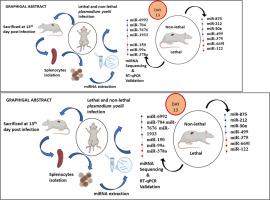Differential expression of miRNAs dictates the susceptibility/resistance during malaria pathogenesis
IF 2.5
3区 医学
Q2 PARASITOLOGY
引用次数: 0
Abstract
Malaria continues to pose a significant global health challenge, with the severity of the disease being influenced by intricate host–parasite interactions. MicroRNAs (miRNAs), which function as post-transcriptional regulators, are pivotal in modulating host immune responses during infection. This study conducted a comparative analysis of miRNA expression profiles in splenocytes of mice infected with two closely related Plasmodium yoelii strains- Py17XL (lethal) and Py17XNL (non-lethal), utilizing small RNA sequencing on day 13 post-infection. A total of 171 and 220 miRNAs were differentially expressed in the Py17XL and Py17XNL groups, respectively, in comparison to uninfected controls. Among these, 79 miRNAs were found commonly dysregulated, while 53 and 86 miRNAs were unique to the lethal and non-lethal P. yoelii infection, respectively. Further, RT-qPCR validation corroborated the expression patterns of selected miRNAs. In Py 17XNL group, miR-875–3p, miR-30a-3p, miR-499–5p, and miR-212–3p were significantly upregulated, whereas miR-6992–5p, miR-704, miR-7676–3p, and miR-1933–3p were predominantly elevated in the Py17XL group. Pathway enrichment analysis indicated that these miRNAs target genes involved in immune-related signalling pathways, including MAPK, mTOR, FoxO, Th-17 cell differentiation and TGF-β signalling. These findings suggest distinct miRNA-mediated regulatory mechanisms underlying lethal and non-lethal malaria outcomes and offer potential molecular targets for therapeutic intervention and biomarker development.

在疟疾发病过程中,mirna的差异表达决定了易感性/耐药性。
疟疾继续对全球健康构成重大挑战,其严重程度受到宿主-寄生虫复杂相互作用的影响。MicroRNAs (miRNAs)作为转录后调节因子,在感染期间调节宿主免疫反应中起着关键作用。本研究在感染两种密切相关的约氏疟原虫菌株Py17XL(致死性)和Py17XNL(非致死性)后的第13天,利用小RNA测序对感染小鼠脾细胞中的miRNA表达谱进行了比较分析。与未感染的对照组相比,Py17XL和Py17XNL组中分别有171和220个mirna差异表达。其中,发现79种mirna普遍失调,53种和86种mirna分别是致死性和非致死性约氏疟原虫感染所特有的。此外,RT-qPCR验证证实了所选mirna的表达模式。在py17xnl组中,miR-875-3p、miR-30a-3p、miR-499-5p和miR-212-3p显著上调,而在Py17XL组中,miR-6992-5p、miR-704、miR-7676-3p和miR-1933-3p显著上调。途径富集分析表明,这些mirna的靶基因参与免疫相关信号通路,包括MAPK、mTOR、FoxO、Th-17细胞分化和TGF-β信号通路。这些发现表明,致命和非致命疟疾结果背后有不同的mirna介导的调节机制,并为治疗干预和生物标志物开发提供了潜在的分子靶点。
本文章由计算机程序翻译,如有差异,请以英文原文为准。
求助全文
约1分钟内获得全文
求助全文
来源期刊

Acta tropica
医学-寄生虫学
CiteScore
5.40
自引率
11.10%
发文量
383
审稿时长
37 days
期刊介绍:
Acta Tropica, is an international journal on infectious diseases that covers public health sciences and biomedical research with particular emphasis on topics relevant to human and animal health in the tropics and the subtropics.
 求助内容:
求助内容: 应助结果提醒方式:
应助结果提醒方式:


